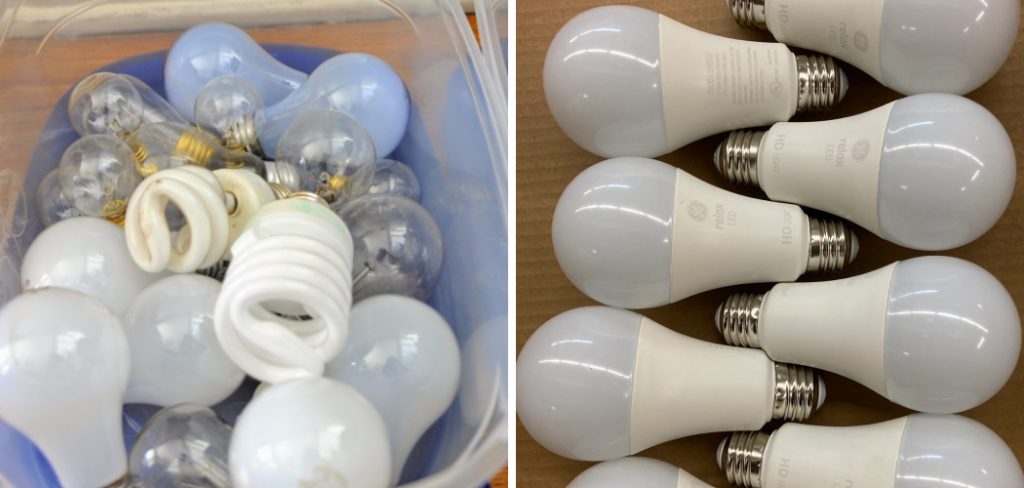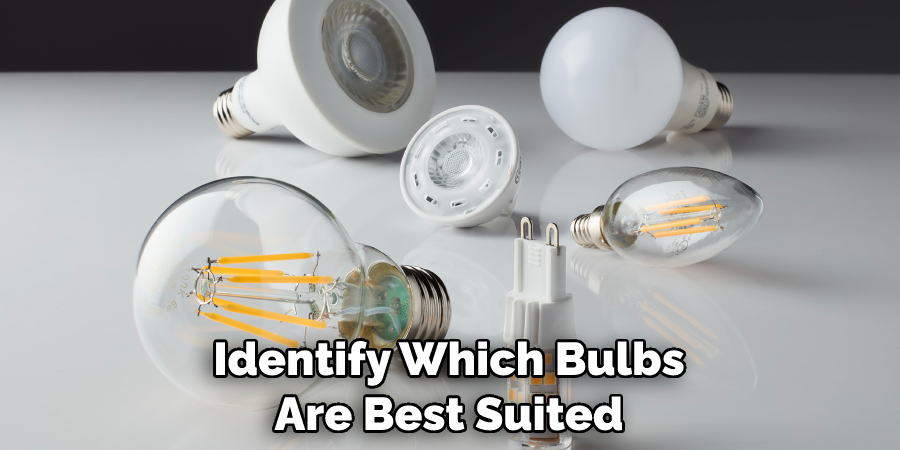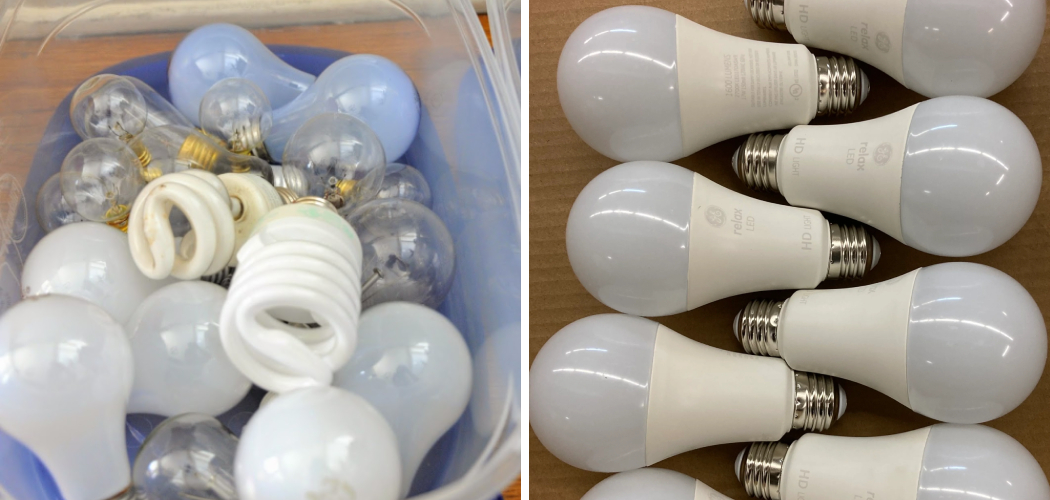Light bulbs are a staple in every household. They play an essential role in our daily lives, providing illumination and warmth during dark and cold days. However, as simple as they may seem, organizing light bulbs can be a daunting task.

Keeping them all in order can be challenging with so many types, sizes, and wattages available. But don’t fret! In this blog post, we’ll provide you with tips and tricks on how to organize light bulbs and make your life easier.
Can You Organize Light Bulbs?
The thought of organizing light bulbs may seem daunting, but it’s a task that can bring a sense of calm to your home. Imagine never having to search through a box of random bulbs again, only to find that none of them fit the fixture you’re trying to light up. With a little bit of effort and organization, you’ll always know exactly where the right bulbs are located.
Plus, organizing your bulbs can also help you identify which ones need to be replaced, ensuring that you always have a well-lit and inviting space. Don’t let the thought of organizing light bulbs intimidate you – it’s an achievable task that can lead to a more efficient and functional home.
Why Should You Organize Light Bulbs?
If you’re someone who has ever fumbled through a pile of light bulbs trying to find the right one, you know just how frustrating it can be.
It’s no secret that organizing your light bulbs can save you time and money in the long run. Not only does it help you quickly identify the bulb you need, but it also helps to prevent you from buying duplicates or mismatched bulbs that don’t fit your fixtures.
With a little bit of effort upfront, organizing your light bulbs can make a big difference in simplifying your life and ensuring you have the right lighting for any occasion.
How to Organize Light Bulbs – in 6 Easy Tips to Follow
1. Sort Them by Type
Light bulbs come in different types, including incandescent, fluorescent, LED, and halogen. To organize them effectively, start by sorting them by type. This way, you’ll be able to identify which bulbs are best suited for different rooms and fixtures. Keep them in separate containers or bags, labeled accordingly. For instance, have a container for LED bulbs and another for fluorescent bulbs.

2. Consider the Wattage
Light bulbs also come in various wattages, ranging from as low as 25 watts to as high as 500 watts. Sorting them by wattage can also help you enhance their efficiency and longevity. Group bulbs with similar wattages in the same storage system will never have to worry about installing the wrong bulb in your light fixtures.
3. Label Your Bulb Containers
Labeling your bulb containers may seem like a no-brainer, but it’s essential. Knowing what’s inside each container saves time, and you won’t have to rummage through a pile of bulbs to find the one you need. Be sure to label the containers with the bulbs’ type and wattage.
4. Store Them in A Cool, Dry Place
Light bulbs are heat sensitive, which means storing them in a hot and damp environment can affect their performance and lifespan. Store your bulbs in a cool, dry place, such as a cupboard, closet, or dedicated storage area to extend their life. Avoid storing them in an area where they’re exposed to sunlight or moisture, as they can weaken their elements.
5. Dispose of Your Old Bulbs Safely
When bulbs burn out, it’s essential to dispose of them safely. Many areas have strict regulations on the disposal of light bulbs, especially mercury-containing bulbs. You can either recycle them or dispose of them as hazardous waste. Store your burnt-out bulbs in a designated container until you can take them to your local recycling center or hazardous waste collection site.
6. Regularly Check and Replace Bulbs
Finally, to ensure your bulbs are always in working order, regularly check and replace burned-out bulbs. Doing this will save you the hassle of searching for a particular bulb later on. It’s also an excellent way to stay organized — you’ll know exactly which bulbs need replacing at a glance.
That’s it! You’ve now learned how to organize your light bulbs in 6 easy tips. With the right storage system, you’ll never struggle to find the right bulb for your fixture again!
5 Considerations Things When You Need to Buy the Organize Light Bulbs
1. The Type of Light Bulb You Need
When you are shopping for light bulbs, the first thing you need to consider is the type of light bulb you need. There are various types of light bulbs on the market, and each one has its advantages and disadvantages. Some of the most popular types of light bulbs include incandescent, fluorescent, halogen, and LED.

2. The Wattage
Wattage is another important consideration when you are shopping for light bulbs. The wattage is a measure of how much electricity the light bulb uses. The higher the wattage, the more electricity the light bulb will use. However, higher-wattage light bulbs also tend to be more bright.
3. The Price
Of course, the price is another important consideration when shopping for light bulbs. Light bulbs can range in price from a few dollars to over $100. It is important to find a light bulb that fits your budget.
4. The Brand
When you are shopping for light bulbs, you may also want to consider the brand. There are a variety of different brands of light bulbs on the market, and some brands are better than others. Do some research to find a brand that you can trust.
5. The Return Policy
Finally, when shopping for light bulbs, you will want to ensure the store has a good return policy. This way, if you are not satisfied with the light bulb, you can return it for a refund or exchange it for another one. This can save you money and hassle in the long run.
By considering each of these factors, you can ensure that you purchase the best light bulb for your needs. Whether you are shopping for a single light bulb or an entire set, organizing them correctly will help maintain their lifespan and efficiency. When it comes to lighting your home, you want to ensure that you have the best products possible.
By considering these considerations, you can ensure that your light bulbs will be both efficient and cost-effective.
Benefits of Organize Light Bulbs
Have you ever found yourself rummaging through a cluttered closet or drawer trying to find a specific light bulb? Organizing your light bulbs not only saves time but also has many other benefits. By grouping them by type and wattage, you can easily find what you need and avoid accidentally using the wrong bulb, which can be dangerous and costly.

Additionally, organizing your light bulbs can help you keep track of when they were last replaced, ensuring that you always have a fully functioning and efficient lighting system in your home. Taking a few minutes to organize your light bulbs can make a big difference in your daily routine and overall home maintenance.
4 Common Mistakes People Make When Trying to Organize Light Bulbs
1. Not Knowing What Type of Light Bulbs You Have
The first mistake people make when trying to organize their light bulbs is not knowing what type of light bulbs they have. There are a variety of different types of light bulbs, including incandescent, fluorescent, and LED. Each type of light bulb has its benefits and drawbacks, so it is important to know which type you have before organizing them.
2. Not Knowing Where to Store Light Bulbs
Another mistake people make is not knowing where to store their light bulbs. Light bulbs should be stored in a cool, dry place away from direct sunlight. If possible, they should also be stored in a dark place, as this will help to prolong their lifespan.
3. Not Labeling the Light Bulbs
A third mistake people make is not labeling the light bulbs. This is particularly important if you have multiple light bulbs, as it can be difficult to remember which type. You can label the light bulbs by their type, wattage, or even just by their color.
4. Not Recycling Old Light Bulbs
Finally, many people make the mistake of not recycling their old light bulbs. Most municipalities have programs for recycling fluorescent light bulbs, and many hardware stores will also accept incandescent light bulbs for recycling.
Where Is the Best Place to Keep Extra Light Bulbs?
Keeping extra light bulbs around is always a smart idea, especially since they seem only to burn out when it’s the least convenient. But where is the best place to store them? Some may say in their garage, others may say in a closet, but I argue that the best place to keep extra light bulbs is in a designated bin or storage container in a utility room or laundry room.
This way, you’ll always know where they are when you need them, and you won’t have to rummage through various drawers or shelves to find what you’re looking for. Plus, it helps you stay organized and ensures that you won’t forget where you put them in the first place. So, next time you’re wondering where to stash your extra light bulbs, consider creating a designated spot in your utility room.

Conclusion
Organizing light bulbs may seem like a minor task, but it can make a huge difference in your home’s energy efficiency and overall aesthetics.
By sorting them by type, labeling your containers, storing them in a dry environment, and disposing of them safely, you can ensure that you always have bulbs on hand when you need them. So, what are you waiting for? Roll up your sleeves, and let’s start sorting! Thanks for reading our post about how to organize light bulbs.

